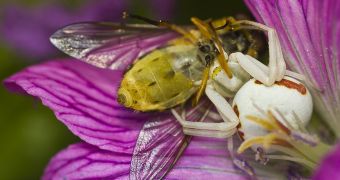Misumena vatiaspider is a species of spiders that, because of its mouthful of a name, is more widely known for its amazing trait. The females in this species are able to camouflage themselves perfectly, mimicking the color of whatever flower they happen to be lurking on, while waiting for some insect to drop by. In a new set of experiments, scientists have determined that white spiders on white flowers capture approximately the same amount of prey as a white spider on a yellow flower, for instance, which is contrary to textbook knowledge, Wired reports.
In a paper published online, in the November 3 issue of the respected scientific journal Proceedings of the Royal Society B, researchers at the University of Fribourg, in Switzerland, show that the color-coordination ability also does not score the crab spiders more dinner. The investigation “finally shatters the myth of crypsis by color matching in crab spiders. I suspect that textbooks may now need to be rewritten,” Macquarie University behavioral ecologist Marie Herberstein says. She was not a part of the new research.
UF expert Rolf Brechbuhl, a study coauthor, said that he and his team watched more than 2,000 instances in which insects hovered over flowers that had spiders in them, all swirled up and ready to snap at their would-be prey. What the new study essentially shows is the fact that the spider does not necessarily use its “cloaking device” for hunting, which raises some tantalizing possibilities. “This paper is exciting, as it shows that we may be focusing our attention in the wrong direction,” Queen Mary University of London ecologist Thomas C. Ings says.
One of the emerging possibilities, some believe, is that the camouflage is used to fend off the spider's predators, although that didn't seem to be the case in the field experiments, the Swiss researcher adds. In over three days of studying the arthropods in their natural habitats, only one instance when a predator (a bird) caught and ate one of the spiders was observed. Another possibility, others believe, would be that the evolutionary trait once helped the creature catch prey and escape undetected, and that evolution simply chose not to remove it from Misumena vatiaspider.

 14 DAY TRIAL //
14 DAY TRIAL //